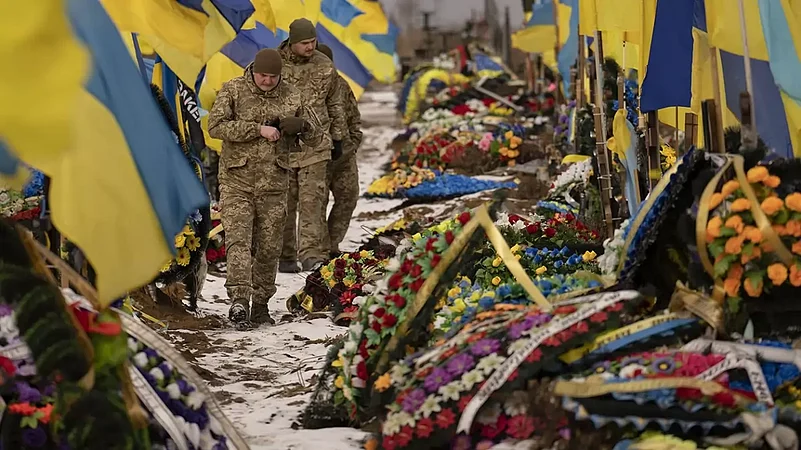A year since Russia invaded Ukraine on February 24, 2022, triggering a widespread panic around global politics, the global economy still seems to be recoiling from the consequences of the bloodshed and terror. Before the memory of the horrors of the Covid-pandemic faded out, there came a sudden crunched supply of grain, fertilizer and energy along with more inflation and economic uncertainty in a world that was already contending with too much of both.
As dismal as the war’s impact has been, there’s one consolation: It could have been worse. Companies and countries in the developed world have proved surprisingly resilient, so far avoiding the worst-case scenario of a painful recession.
But in emerging economies, the pain has been more intense.
As we enter a one-year cycle since the war, we look back at the global economic crisis that took its shape from wartime horrors.
According to the International Monetary Fund (IMF), impacts on the global economy will flow through three main channels. One, higher prices for commodities like food and energy will push up inflation further, in turn eroding the value of incomes and weighing on demand. Two, neighbouring economies in particular will grapple with disrupted trade, supply chains, and remittances as well there as would be a historic surge in refugee flows. And three, reduced business confidence and higher investor uncertainty will weigh on asset prices, tightening financial conditions and potentially spurring capital outflows from emerging markets.
Russia and Ukraine are major commodities producers, and disruptions have caused global prices to soar, especially for oil and natural gas.
In Europe, for example, natural gas prices are still three times what they were before Russia started massing troops on Ukraine’s border.
According to a report by Business Today, at the beginning of 2022, brent crude prices stood at around $80 per barrel. Soon after the Russia-Ukraine crisis hit the global economy like a thunderbolt, brent crude went as high as $128 per barrel. Crude oil prices scaled a new high with brent crude reaching $122.8 per barrel on May 31.
In 2022, it was estimated by the IMF that countries, which are dependent on oil imports, would see wider fiscal and trade deficits and more inflation pressure, though some exporters such as those in the Middle East and Africa may benefit from higher prices.
Simultaneously, the IMF says consumer prices jumped 7.3 per cent in the wealthiest countries last year — above its January 2022 forecast of 3.9 per cent — and 9.9 per cent in poorer ones, up from 5.9 per cent expected pre-invasion. And in the US, such inflation has forced businesses to be nimble.
In the current situation, punishingly high food prices are inflicting particular hardship on the poor. The war has disrupted wheat, barley and cooking oil from Ukraine and Russia, major global suppliers for Africa, the Middle East and parts of Asia where many struggle with food insecurity. Russia also was the top supplier of fertilizer.
Last year, Russian hostilities in Ukraine prevented grain from leaving the “breadbasket of the world” and making food more expensive across the globe, threatening to worsen shortages, hunger and political instability in developing countries.
Together, Russia and Ukraine export nearly a third of the world’s wheat and barley, more than 70 per cent of its sunflower oil and are big suppliers of corn. Russia is the top global fertilizer producer.
In Nigeria, a top importer of Russian wheat, average food prices skyrocketed 37 per cent last year. Bread prices have doubled in some places amid wheat shortages.
However, the scenario was slightly different in India when the production of wheat picked up in the country. The impact of the war had a boosting effect for the country’s rural economy as India is the world’s second largest production of grains.
But, however, the crisis only deepened in other countries of the world.
In the Indonesian capital, Jakarta, many street vendors know they can’t pass along surging food prices to their already struggling customers. So some are skimping on portions instead, a practice known as “shrinkflation.”
In Spain, the government is spending 300 million euros ($320 million) to help farmers acquire fertilizer, the price of which has doubled since the war in Ukraine.
At least 40 per cent of bakeries in the Nigerian capital of Abuja shut down after the price of flour jumped about 200 per cent.
It all means a slowing global economy. The International Monetary Fund dropped growth expectations this year and in 2022 that equates to about $1 trillion in lost production. Europe’s economy, for example, “is still experiencing significant headwinds” despite a drop in energy prices and is at risk of falling into recession, said Nathan Sheets, global chief economist at banking giant Citi.
(with AP inputs)
















